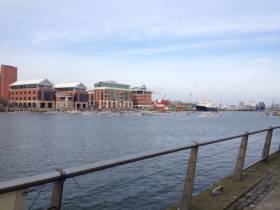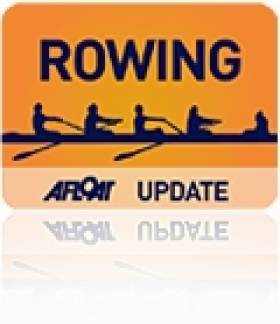Displaying items by tag: rowiing
Portora Eight Best Queen's Intermediates at Lagan Head
| Lagan Head of the River 2015 - Race 2 4200m at 13:30hrs |
|---|
| RESULTS by Time - Provisional - Masters handicap not applied |
| POSITION CREW |
| NUMBER Club Class Cox/Steerer Time % of winning |
| time Comments |
| 1 1 Portora Mens J18A 8+ R Farragher 14:35.4 100.00 |
| 2 7 QUBBC Mens Intermediate 8+ C Moorehead 14:37.4 100.23 |
| 3 15 Yarm School Mens Club 1 8+ O Cairns 15:08.7 103.81 |
| 4 14 Commercial Mens Club 1 8+ S Eustace 15:08.7 103.81 |
| 5 9 DUBC Mens Intermediate 8+ H Mulvaney 15:12.8 104.27 |
| 6 12 Portora Mens Senior 4X- B Rix 15:14.7 104.49 |
| 7 8 St Josephs Mens Intermediate 8+ C R Wanjau 15:14.7 104.49 |
| 8 2 Methodist A Mens J18A 8+ A Mawhinney 15:22.7 105.40 |
| 9 4 Commercial Mens J18A 8+ B McGuiness 15:28.6 106.08 |
| 10 29 Comm/OCBC/Neptune/BBC (d ) Mens Masters 8+ J Malloy 15:46.6 108.13 |
| 11 17 QUBBC Mens Club 1 8+ A Sloan 15:51.4 108.68 |
| 12 21 St Josephs A Mens J16 8+ E Finnegan 16:13.2 111.17 |
| 13 5 Neptune Mens J18A 8+ A Gillick 16:22.8 112.27 |
| 14 3 RBAI Mens J18A 8+ M Honan 15:22.7 105.40 |
| 15 10 Belfast RC / Lagan Mens Senior 4X- T McGivern 16:24.4 112.46 |
| 16 26 QUBLBC Womens Intermediate 8+ G Canham 16:32.1 113.33 |
| 17 25 DULBC Womens Senior 8+ N Williams 16:32.1 113.34 |
| 18 19 Neptune Mens Club 1 8+ P Dolan 16:36.0 113.78 |
| 19 18 DUBC B Mens Club 1 8+ A McCormick 16:44.4 114.74 |
| 20 16 DUBC A Mens Club 1 8+ C Keogh 16:47.2 115.06 |
| 21 22 Portora Mens J16 8+ B Corrigan 16:47.3 115.06 |
| 22 34 Bann Womens Senior 4X- A Odonovan 16:52.1 115.61 |
| 23 27 DULBC Womens Intermediate 8+ B Murphy 17:00.4 116.57 |
| 24 31 Belfast BC (f ) Mens Masters 8+ E Bell 17:00.6 116.59 |
| 25 40 Portora Womens J18A 8+ S Dolan 17:01.3 116.67 |
| 26 30 Belfast RC (f ) Mens Masters 8+ S Mairs 17:04.2 116.99 |
| 27 13 St Josephs Mens Senior 4X- F Vickers 17:07.0 117.31 |
| 28 24 Methodist Mens J16 8+ C Woods 17:12.9 117.99 |
| 29 28 Bann (d ) Mens Masters 8+ C Mitchell 17:13.3 118.04 |
| 30 11 Lagan Mens Senior 4X- P Cross 17:15.6 118.30 |
| 31 6 Methodist B Mens J18A 8+ D Morrow 17:25.5 119.43 |
| 32 20 DUBC C Mens Club 1 8+ J Davis 17:38.6 120.93 |
| 33 37 Commercial Womens Senior 4- K Curran 17:42.5 121.37 |
| 34 32 LVBC (f ) Mens Masters 8+ M Warnock 17:49.4 122.16 |
| 35 41 Commercial A Womens J18A 8+ S Carpenter 17:51.1 122.36 |
| 36 38 Methodist Womens J18A 8+ S McKeown 18:22.1 125.90 |
| 37 46 Belfast BC (e ) Womens Masters 8+ C Watters 18:28.4 126.62 |
| 38 45 Yarm School Womens Club 1 8+ J Dodds 18:31.6 126.98 |
| 39 36 QUBLBC Womens Senior 4- A Buck 18:32.0 127.03 |
| 40 43 DULBC A Womens Club 1 8+ C O'Donnell 18:34.1 127.26 |
| 41 35 Belfast RC Womens Senior 4X- L Taylor 18:50.0 129.09 |
| 42 49 Portora A Womens J16 8+ R Conway 18:56.0 129.77 |
| 43 42 DULBC B Womens Club 1 8+ S Oster 19:40.0 134.80 |
| 44 50 Commercial Womens J16 8+ K Hynes 19:49.4 135.87 |
| 45 39 Commercial B Womens J18A 8+ E Hoban 20:05.8 137.75 |
| 46 47 Belfast RC (c ) Womens Masters 8+ S Smith 20:21.0 139.48 |
| 47 23 St Josephs B Mens J16 8+ B Holland 20:22.8 139.68 |
| 48 33 Portadown Womens Senior 4X- A Martin 21:04.0 144.39 |
| 49 48 Portora B Womens J16 8+ D Hutton 21:47.1 149.31 |
| 50 44 Belfast BC Womens Club 1 8+ J Penman 23:30.1 161.08 |
| 51 51 Yarm School Womens 14 4X+ F Willmott 26:12.5 179.64 |
| Lagan Head of the River is organised by Belfast Rowing Club |
| with assistance from Lagan Scullers Club, Methodist College Boat Club, RBAI Rowing Club |
| and Belfast Boat Club |
| and Belfast Harbour Commissioners, Belfast City Centre Regeneration Directorate |
| SSE Arena |
| Powerhouse Sport |
Puspure Bound For B Final at Lucerne
#Rowing: Sanita Puspure finished fifth in the A/B Semi-Final of the women’s single sculls at the World Cup regatta in Lucerne today. She is now set to compete in the B Final. Kim Crow of Australia set a hot pace, with Genevra Stone and Fie-Udby Erichsen of Denmark filling second and third in the early stages. Puspure was fifth after 500 metres and did not improve that position as the race went on. Fiona Bourke of New Zealand took third behind Crow and Stone.
World Cup Regatta, Lucerne – Day One (Irish interest; selected results)
Men
Lightweight Pair – Repechage (First Four to A Final): 4 Ireland (M O’Donovan, S O’Driscoll) 6:50.28.
Women
Double Sculls – A/B Semi-Final (First Three to A Final; rest to B Final): 1 Belarus 7:14.98, 2 Germany 7:17.52, 3 Greece 7:19.13; 5 Ireland (H Hannigan, L Dilleen) 7:26.75.
Lightweight Double – A/B Semi-Final (First Three to A Final; rest to B Final): 1 South Africa 7:35.26, 2 US 7:36.79, 3 Germany 7:39.14; 5 Ireland (C Lambe, S Jennings) 7:44.11
Single Sculls – A/B Semi-Final (First Three to A Final; rest to B Final): 1 Australia (K Crow) 7:55.81, 2 United States (G Stone) 8:00.20, 3 New Zealand (F Bourke) 8:03.10; 5 Ireland (S Puspure) 8:11.50.
Lightweight Single – Repechage One (Two to A Final; rest to B Final): 3 Ireland (D Walsh) 8:11.47.






























































